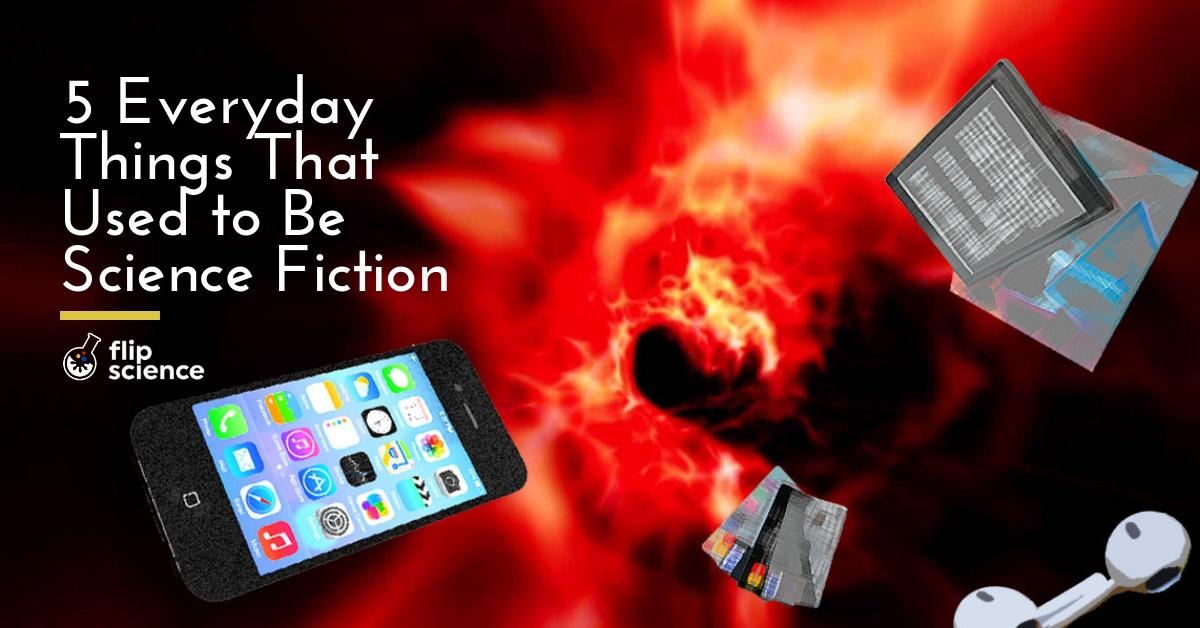Over the decades, innovations in science and technology have advanced society in impressive ways. In some cases, we’ve even turned the science fiction marvels of yesteryear into today’s reality. Here are 5 examples of things that used to occupy the imaginary worlds of science fiction writers, but have now become rather common in our everyday lives.
1) Video calling (or videotelephony)
Fiction: 1878
Reality: 1964
Humanity’s fascination with long-distance video calling began almost as soon as we realized that it was possible for two people who weren’t in the same room to hear each other through a bunch of wires. Two years after the telephone was patented in the United States, a sketch of a fictional invention called a “telephonoscope” was published in Punch Magazine on December 9, 1878. The concept of videotelephony would continue to be explored in various written works, such as Le Vingtième siècle. La vie électrique (The 20th Century. The Electrical Life) by Albert Robida in 1890 and Ralph 124c 41+ by Hugo Gernsback in 1911.
Pinpointing the exact date when videotelephony crossed over from fiction to fact is a bit challenging, given its long and colorful history. However, the earliest public demonstration of a reasonable approximation of today’s typical video calls took place at the 1964 New York World’s Fair, where American telecomunnications company AT&T called Disneyland in California via their Picturephone Mod I on April 20, 1964 — the first transcontinental video call.
2) Wireless earphones/earbuds
Fiction: 1953
Reality: 2015
In Ray Bradbury’s novel Fahrenheit 451, he described “thimble radios,” tiny shells that fit inside the human ear and produced “an electronic ocean of sound, of music and talk and music and talk.” While bulky headphones and other wired hearing devices were already around at the time–in fact, a patent for phonograph hearing tubes, which were basically rigid earphones, was issued in 1910–true wireless devices for communication that fit inside the ear weren’t.
Wireless earbuds (like the ones that come with newer versions of the iPhone) only started showing up in 2015, when Japanese electronics company Onkyo unveiled what they called “the world’s first ‘true wireless’ in-ear headphones,” which use Bluetooth technology to connect to smart devices.
3) e-Book readers
Fiction: 1930 (or 1961)
Reality: 1998
The first time someone wrote about the prospect of a portable electronic reader of sorts was in 1930, when Bob Brown published a manifesto called The Readies. In it, he described a total transformation of language and written communication, as opposed to just a simple portable reading device. Thus, historians aren’t really sure whether to count this as the first time e-Book readers appeared in science fiction, or Stanislaw Lem’s Return from the Stars (1961). Lem wrote about an “electronic laboratory” that allowed access to information, instead of manually browsing through tall shelves or thick books. Meanwhile, Douglas Adams put forward the idea of a similar device in Hitchhiker’s Guide to the Galaxy (1978). His idea resembled a large electronic calculator with buttons and a 4-inch-by-4-inch screen that allowed the holder to “read” its “pages.”
With the dawn of new file formats for e-Books (such as the PDF in the early 1990s), the digitalization of books took a giant leap forward from previous efforts in past decades. The first handheld reader, the Rocket e-Book, was produced and sold by NuvoMedia in 1998. In subsequent years, e-Book reader options have grown in number, and various e-Book formats have been introduced.
4) Mobile phones
Fiction: 1966
Reality: 1973
If you were to look at the history of the mega-popular Star Trek franchise, you would find that it inspired quite a few technological innovations. Among the most ubiquitous, of course, is the mobile phone (which has further evolved into today’s smartphones). Back then, the idea of a single handheld device that could play video and audio, take photos, transmit data, and other functions was far out. Star Trek was among the first to embrace this idea, featured handheld wireless devices that allowed the characters to communicate with their starships.
It has been said that these episodes inspired Motorola’s Martin Cooper to invent the mobile phone, which he demonstrated with John F. Mitchell in 1973.
However, Cooper has gone on record to say that Star Trek did NOT inspire the creation of the mobile phone. In fact, the idea had already been germinating inside the Motorola offices years before Star Trek even hit the air waves. To quote a recent article by Comic Book Resources‘ resident fact-checker, Brian Cronin:
Cooper said that he was just so overwhelmed by the movie that he conceded to something that he did not actually believe to be true. He also noted that, if he HAD to pick a piece of pop culture that inspired the idea, it would instead be Dick Tracy’s famous wrist watch communicator…
Either way, Cooper’s main message is that he was working on the technology well before Star Trek, so whether Dick Tracy should get the credit or not, it wasn’t Star Trek that inspired it.
Regardless of what inspired it, the portable phone was a truly remarkable piece. It was heavy–it weighed 2 kilograms!–but it was a huge step forward from what was thought to be possible at the time.
5) Credit cards
Fiction: 1888
Reality: 1946
In the 1888 novel Looking Backward by Edward Bellamy, the characters used cards instead of actual money to purchase things. They no longer needed to carry coins or paper money with them; all they had to do was use their cards, which were connected to a central bank. Instead of borrowing, though, these cards used the holder’s allocated funds, making them closer to debit cards in function.
However, it would take almost 60 years for this to become a reality. The roots of the modern credit card can be traced to the Flatbush National Bank of Brooklyn. In 1946, its president, John Biggins, introduced the “Charge-It” program, which allowed account holders to make purchases without having to use actual money upfront.
Editor’s note: An earlier version of this article stated that Star Trek was the inspiration for the mobile phone. However, this notion has recently been debunked by the inventor of the mobile phone himself. The entry for the mobile phone has been updated accordingly.
Cover photo: Pexels; Chris Leroux
References
- http://www.terramedia.co.uk/Chronomedia/years/Edison_Telephonoscope.htm
- https://web.archive.org/web/20120623215926/http://www.porticus.org/bell/pdf/picturephone.pdf
- https://www.wired.com/2012/04/april-20-1964-picturephone-dials-up-first-transcontinental-video-call/
- http://metaphors.iath.virginia.edu/metaphors/23859
- https://patents.google.com/patent/US1096024
- https://www.telegraph.co.uk/technology/news/11841729/Worlds-first-truly-wireless-headphones-unveiled.html
- https://www.theverge.com/2015/1/9/7512829/wireless-earbuds-ces-2015-bragi-dash
- https://web.archive.org/web/20161129174227/https://books.google.com/books?id=Jn6PQAAACAAJ
- http://www.gutenbergnews.org/20110716/ebooks-1998-the-first-ebook-readers/
- https://www.forbes.com/sites/michaelvenables/2013/04/03/captain-kirks-call-to-spock/#244a5189a92c
- https://www.businessinsider.com/history-of-credit-cards-2015-2
- https://www.brownstoner.com/history/bank-credit-card-brooklyn-flatbush-national-bank-history/
- http://www.theautomaticdoorco.com/resources/the-history-of-automatic-doors/
- https://www.cbr.com/star-trek-communicators-martin-cooper-cell-phone/
Author: Mikael Angelo Francisco
Bitten by the science writing bug, Mikael has years of writing and editorial experience under his belt. As the editor-in-chief of FlipScience, Mikael has sworn to help make science more fun and interesting for geeky readers and casual audiences alike.







